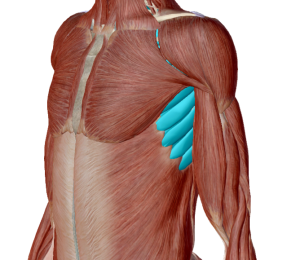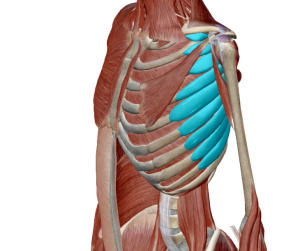I think our ribcage and shoulder are some of the least understood parts of our bodies. Having said that, they are some of my favorite topics of discussion. This is what brings me to write blog #4 on rib control and serratus anterior muscles. This blog hopes to address why it will benefit you to understand your serratus muscles, the benefits of rib control, and how both can help prevent shoulder and back injuries. Finally, I want to make you a stronger, more whole version of yourself, so learning about these muscles can help to do that.
Lets shine some light on our serratus anterior, one of the most overlooked muscles that helps to stabalize the shoulder and mobilize the ribcage. Your serratus muscles work as an antagonist to your rhomboids, the set of muscles between your scapulae that help to draw your shoulder blades toward one another. The serratus’ prime function is to do three things: keep the scapula close to the back of your ribcage, to assist in bringing the scapula forward and around the front of the thorax, and lastly to elevate and expand the ribcage, specifically ribs 1-9. It works in harmony with the other rotator cuff muscles to create stability in the shoulder, while promoting freedom and mobility throughout the ribcage.
 You may be thinking, why does this matter? Well, if you’re any sort of athlete; runner, swimmer, weightlifter, CrossFitter, yogi, climber, or a person trying to move and stay fit, (pretty much anyone), your serratus anterior can help you to strengthen your abdominal core and shoulder girdle. Not only does it add support to the demands you put on your shoulders, but it assists in respiration by lifting the ribcage up so the lungs can function better. So by ways of activating your serratus muscles you can actually begin to create space for your lungs to breathe more deeply, efficiently, leading to an increase in efficiency of stamina. It is this lift that the serratus anterior produces that will help to create space in your ribcage so that you can deepen your breaths when fatiguing during movement and activity.
You may be thinking, why does this matter? Well, if you’re any sort of athlete; runner, swimmer, weightlifter, CrossFitter, yogi, climber, or a person trying to move and stay fit, (pretty much anyone), your serratus anterior can help you to strengthen your abdominal core and shoulder girdle. Not only does it add support to the demands you put on your shoulders, but it assists in respiration by lifting the ribcage up so the lungs can function better. So by ways of activating your serratus muscles you can actually begin to create space for your lungs to breathe more deeply, efficiently, leading to an increase in efficiency of stamina. It is this lift that the serratus anterior produces that will help to create space in your ribcage so that you can deepen your breaths when fatiguing during movement and activity.
The serratus acts as additional support to our shoulders by bringing the ribcage into the equation when placing load or stress onto the rotator cuff. It’s like a win-win muscle (as are most muscles). By using it you create more muscular recruitment throughout your body, and the byproduct ends up being better breathing and a more secure shoulder. Wow- what athlete or average person wouldn’t want that? Another benefit? If you can get your serratus to activate and work, it will let your upper trap and lat relax, leading to less neck irritation as well. In our society, especially the weekday grind, our traps and lats are constantly over working, producing forward head posture, rounded upper backs, and extremely protracted shoulders. So in my opinion, by firing this group of muscles we can maintain healthy length on our necks and improve alignment of the neck to the shoulders. Once the scapulae learn how to stay down and back this will give us a healthier moving shoulder, with wider range of motion and a greater sense of stability.


So how can serratus help to prevent injury? It does this because of its’ deep connection to our shoulders and core. And since shoulders are something most of us can understand easily, the exercises I’ve provided for you in the video are something you can do on your own and begin to feel working. The movements will teach you what it means to develop rib control and active your midline, which will lead to better movement without compromising spinal integrity. Because of the close relationship between the shoulders and the ribs via the serratus muscles, I’m hoping to teach you awareness of your core with these two simple exercises. Great for a warmup, days off, or any time your shoulder, neck, or back feels wonky and you want a reset. If I can make you to feel your serratus muscles via shoulder movements like in the video, there may be a way to teach you how to feel your rib control (core) in other athletic positions. Rib control will make your core to stay active, and hopefully this will get you to feel what it means to have “ribs down” in almost any athletic position. These exercises will help to prevent ongoing pain in various parts of the spine, eventually leading to no more pain. It’s a journey where you get to teach your brain and body what it means to truly have an active core. I hope that it helps and that it improves your core strength, awareness, and activation.
Thanks for reading!
